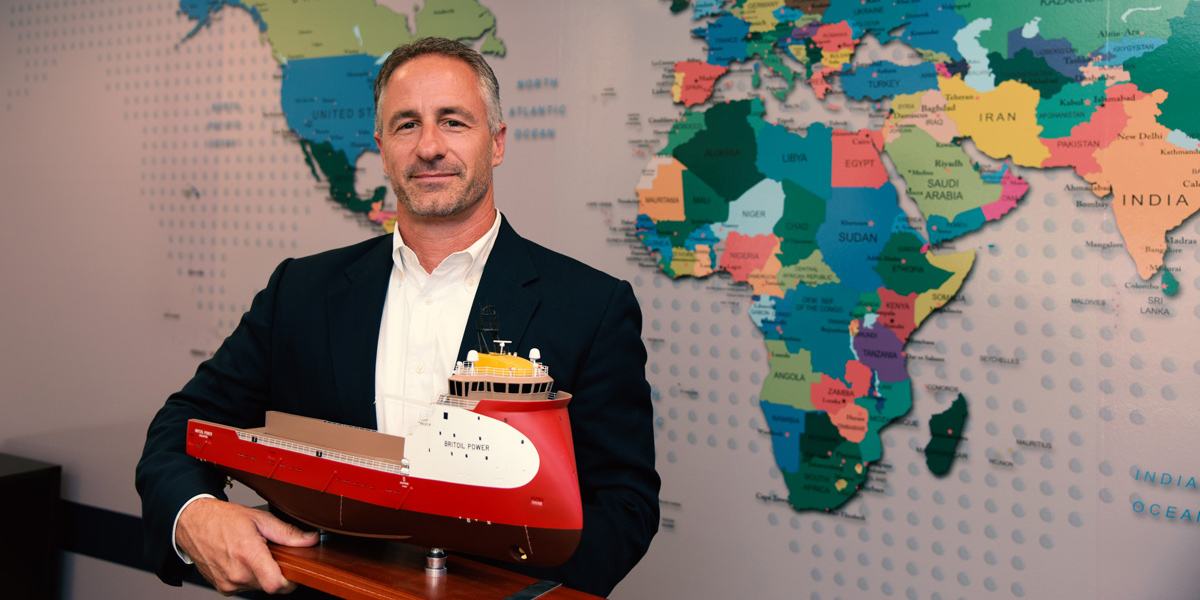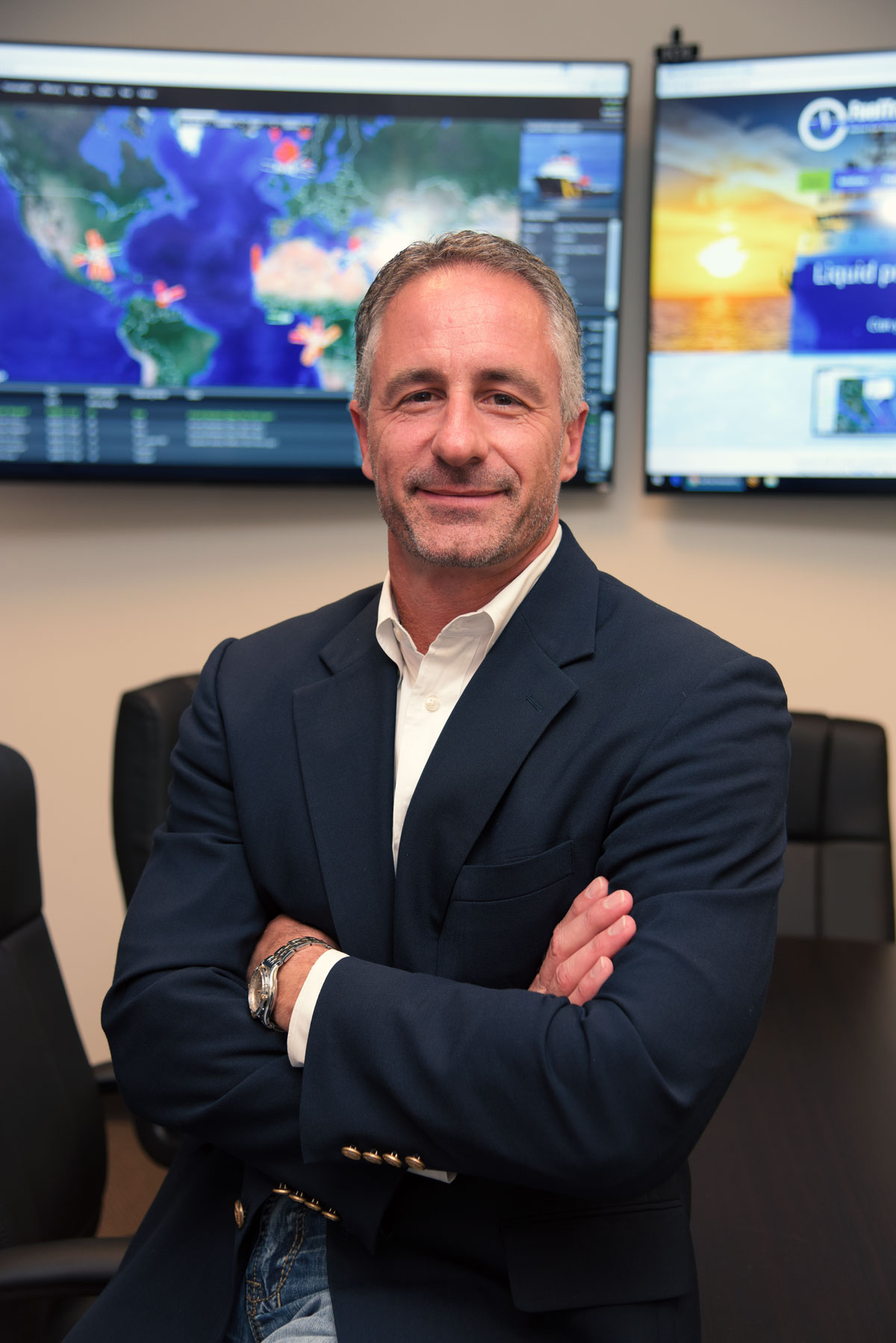
Anthony George, ’88 found himself waiting at the end of a long dirt road in the Louisiana delta, waiting for his skiff to come in.
Soon, he would be plying the waterways aboard the titans of transport—tugboats and their mammoth barges—while a problem weighed on him as heavily as the cargo they moved—how to eke out more efficiency? Then the idea struck him—a solution straight out of one of his Lamar University physics classes. In that eureka moment was born George’s second company, one that spawned an enterprise that is growing exponentially and spans the globe.
From an early age, Anthony George approached life with an entrepreneurial edge and the independent spirit to be his own boss. His parents had successful professional careers and instilled in George a drive for both success and freedom from routine schedules. He was inspired by a friend’s father, a very successful entrepreneur who recommended that he “go to college, get good work experience, then go out on your own,” George said. “I saw in his lifestyle the freedom he had and was very impressed by that.”
In being an entrepreneur, he saw “the opportunity to create something from nothing, to try my own ideas, [and] to not be limited in my creativity,” George said. Fueled by this passion, he “dabbled horribly in real estate and a few other things” before heeding his mother’s advice to “get a degree to have something to fall back on.”
He began his time at LU majoring in electrical engineering and computer science. “I recognized even then that personal computers were going to matter,” he said of a time when a Honeywell mainframe and VAX system were in use; however, four years into the two degrees, while holding demanding jobs outside of school, he sought to parlay those experiences into a degree in physics with the help of Joe Pizzo, distinguished professor emeritus and then physics department chair.
“I remember going to see Dr. Pizzo and he lined out a two-year plan for me,” George said. “He wanted to know if I was a ‘physics head’ and if I wanted to teach. I told him I wanted to get out and start my own company. He helped arrange a plan so I could finish my degree. I owe him a debt of gratitude.”
George graduated in 1988 with a degree in physics and a double minor in electrical engineering and computer science.
During his last three years at LU, George worked part-time for Emerson Automation Solutions of Austin, where he learned about distributive control systems, a newly developed computer technology for running manufacturing processes and facilities. When he graduated, he quickly received multiple job offers based not only on his degree but also on his work experience.
He accepted a position with the control systems group for Petrocon Engineering in Beaumont, and just three months later an offer came to join Temple-Inland in Evadale where they had similar systems deployed.
"I had no idea that the first company I was going to build would be related to my career," he said. "I was just out looking. I was reading multiple books on entrepreneurship, how to grow companies, educating myself on the business side of things." He also took advantage of every business seminar offered by the John Gray Institute at LU.
 He found his first opportunity for innovation at his new job, where he soon learned that the antiquated controls for the pulp side of the mill were falling apart and that the company was looking at a proprietary system with an $8 million price tag. "I had done research on PC-based controls, so I had this vision that what PCs were doing in the office environment, once they became robust enough, could be integrated into the industrial environment."
He found his first opportunity for innovation at his new job, where he soon learned that the antiquated controls for the pulp side of the mill were falling apart and that the company was looking at a proprietary system with an $8 million price tag. "I had done research on PC-based controls, so I had this vision that what PCs were doing in the office environment, once they became robust enough, could be integrated into the industrial environment."
"I bet on that trend," he said. He approached his boss wit ha suggestion that he could automate half of the mill by Christmas for just $100,000. "He said, 'You're crazy,' but I just said it will work," George said. "Not knowing what you don't know, that can be advantageous." His boss said yes.
"I went home that night sick as a dog," George said. "I didn't sleep at all that night thinking 'what have I done? My career...if I fail, I've ruined it!"
After the initial shock, he began working many long hours on innovating a new system to automate the pulp side of the mill. By Christmas, he "had half of that plant running on six 386-33 PCs doing complex cascade loop control," including bleaching pulp and other mill processes. "The operators loved it," said George. "They called it the 'Mattel System' because it was colorful and looked like a toy. But it was incredibly reliable," so reliable, in fact, that it helped increase business at the mill to $300 million a year, and "every dollar ran through those PCs."
"I learned an incredible amount at that job," George said. "I even received a nice raise and a letter of commendation from corporate." More significantly, the idea for his first company was born. "I thought, 'surely other people would pay me to do this,'" George said.
He started Control Dynamics in 1991 based on open systems architecture where he provided engineering services that integrated software and off-the-shelf PCs to provide control automation. Using this approach, he could provide the service offered by proprietary systems for "20 cents on the dollar."
Together, Baskar and George successfully completed the first project. The company grew from two employees in 1991, to 100 in 2000 with $20 Million in annual business doing work primarily in forest products, pipelines and foods, including work with Frito Lay helping develop the Scoop Chip. The 2001 recession and post 9/11 slowdown led the company to "back up and retool, focusing on oil and gas." They developed Universal Master Control Systems for offshore production and hold joint patents with ExxonMobil.
"Reading about the successes makes it sound easy, but everything I learned about business I learned the hard way," George said. "I probably have a Ph.D. in it now, but I made every single mistake, twice. It just took a while for me to figure it out."
Paying great attention to getting the right people is paramount to his success. "Today, it takes me several months to hire one person," he said. "I've surrounded myself with super smart leadership and managers with some from Lamar University.
One of those was Port Arthur native Van Wilson, who graduated LU in 1992 with a degree in Human Resource Management. He joined Control Dynamics in 1996. "He had such high integrity, and worked his way up the channel, that, in the early 2000s when I decided to focus on oil and gas, I chose to make him president," George said.
Having Wilson in the position was a "great move" and allowed George to focus on other areas of his growing business."
In October 2003, George got a call from college friend Adam Fadhli '86, founder and CEO of Discovery Information Technologies in Nederland. Fadhli had a potential customer who wanted to measure fuel consumption on a tugboat, a request that was outside Fadhli's scope. " He asked if I wanted to look into it," George said. "With all that automation experience, from cookies and potato chips to sewage treatment plants and gas pipelines, I wasn't afraid to stick my nose into anything."
He quickly recognized that the tug's fuel piping layout looked a lot like a field pipeline control system in miniature, something his company had a great deal of experience in.
The potential customer, Kirby Inland Marine, is the nation's largest operator of inland tank barges and towing vessels. George introduced his new control system design to Kirby for measuring fuel consumption. "They told me, 'This is great, but unless it saves us money on fuel, we can't sell it to management," George said.
Designing a complete marine fuel management system soon followed. " I started riding tugs 24 hours a day up and down the Mississippi, watching how they operate, and I recognized the physics behind the relationship between the forces acting on the hull and the power of the vessel," George said. He was looking for ways to make the tug's fuel consumption more efficient.
"It was Newton's second law of motion," he said. " So, I designed with some other smart engineers, algorithms to help the captain set the throttle to the most economic setting for the given environmental conditions."
This new technology spawned FuelTrax and, ultimately, Houston-based Nautical Control Systems LP in 2006. Nautical Control Solutions LP manufactures and supports FuelTrax which provides real-time monitoring and optimization recommendations for marine fuel use, alongside FuelNet, which allows access to the FuelTrax data online, anytime and anywhere. FuelTrax delivers fuel-saving efficiencies and clear visibility into marine operations.

"FuelTrax determines how hard the vessel is working," George said. "We used equations that I learned under Dr. Pizzo that I would not have understood had I not changed my major to physics. I look back on that and think how fortuitous that decision was. I remember when my dad asked me, 'Son what are you going to do with a physics degree?' Well, Dad, in 20 years I'm going to invent FuelTrax."
With strong employees continuing the growth of Control Dynamics, George focused on Fuel Trax, growing from its first installation on small, inland tugboats in 2004 to multiple global patents in the USA, Canada and across Europe and installations on all major classes of vessels.
"FuelTrax is the No. 1 marine fuel management product in the world today," George said. It has become the global standard, only through the continued support and interest of its users. "Our clients drive our product development, since day one with Kirby," he said. " This is why we are listed as a sole source for BP, ENI Petroleum
Propelling FuelTrax sales are two huge forces--market pressures demand for greater efficiency in operations in the US, Canada and Europe and the necessity to deter fuel theft in other regions of the world.
“Fuel theft in many parts of the world is endemic,” George said. The ability to monitor marine fuel loading, quality and use in near real-time around the globe is a game changer, he said. With a quarter million vessels in the world, George sees a multi-billion-dollar market in taking fuel tracking from the dipstick to
digital automation.
To focus on that potential and growth at NCS, George sold Control Dynamics to ENGlobal Automation Group in 2010. Today, FuelTrax is growing at 200 percent a year, and accelerating, he said. “They tell us the return on investment on our product is so great it makes installation a simple accounting decision,” George said.
“I’m having so much fun growing the No. 1 fuel management company in the world,” George said. “This is a once in a lifetime event—having a specialty niche, which was opened by the continued development of our product with the support of the largest oil companies in the world.”



